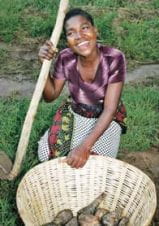A livelihood is a way of supporting your existence. It is made up of the capabilities, assets and activities needed for a means of living. Individuals, households and communities will use the assets available to them to engage in a livelihood that allows them to sustain their families, and even prosper. These include:
- Physical assets, such as land, agricultural tools and livestock.
- Human and spiritual assets, such as job skills, knowledge and religious beliefs.
- Social assets, such as support from church and community members.
Sustainable livelihoods are ones that support families throughout the year. They are able to recover from shocks, such as floods or droughts, and can be maintained over a long period of time. Sustainable livelihoods include actions that do not put people at risk of contracting HIV or make them more vulnerable to the impact of the disease.
How do you apply a ‘livelihoods lens’?
A ‘livelihoods lens’ is a tool which helps us to examine and understand what is happening in a given context. The lens helps us to consider the strengths and weaknesses of a community in relation to HIV and livelihoods (see case study).
Tearfund is in the process of developing a practical, step-by-step guide to applying a livelihoods lens to HIV activities. The guide, entitled Think livelihoods! is designed for churches and faith-based organisations. It will take you through a series of questions on the components of a Sustainable Livelihoods Framework (see diagram, page 15). The questions will show you how each component relates to your HIV intervention and your target group, ultimately helping you to develop new and more holistic responses. The guide will be available in early 2010.
Why should you apply a livelihood lens to your HIV programme?
Applying a livelihoods lens to an HIV programme will help it to:
- reach its HIV-related objectives more effectively, such as enhancing HIV treatment outcomes, improving care and support outcomes
- bring greater sustainability to the HIV-related outcomes, ensuring that the results last beyond the programme’s duration
- emphasise the priorities of the people that benefit from it
- build on the existing strengths of your targeted group and help them to become more resilient to future shocks
- help the implementers to contribute to the holistic well-being of the community.
Kara Greenblott is a consultant specialising in HIV, livelihoods and food security for organisations such as the UN and various NGOs. Kara has lived and worked in Africa and South-east Asia for 11 years.
For more information, contact Ari Clowney. Ari is the Innovations Officer for the HIV team.
Email: [email protected] Web: www.tearfund.org/hiv/response

Livelihoods and HIV
Sustainable livelihoods are particularly important for people living with and affected by HIV. There is a two-way relationship between HIV and livelihoods. This relationship can be seen in the diagram.
- HIV undermines livelihoods Illness and death are likely to undermine livelihoods options. For example, as people become ill, they cannot work in the fields or maintain a job. Parents dying of AIDS-related illnesses will not be able to teach their children important agricultural and vocational skills, which puts the futures of those children at risk.
- Insecure livelihoods make people vulnerable to HIV When livelihoods are not secure, the risk of contracting HIV can increase. Women may be forced to sell sex to survive, or orphans to begging in the marketplace. Both are risky ways to earn an income. Without secure livelihoods, a person already living with HIV may not be able to afford the good nutrition, medical costs, including antiretroviral drugs and transport to clinics, which will enable them to remain healthy and strong.
Case study
A community uses the ‘livelihood lens’ tool and works out that they have a physical asset, which is access to land to raise small livestock. However, they also work out their weakness is restricted access to water. Using this information the community decides to raise goats instead of pigs, as goats need less water to thrive than pigs. This means that people will not be using valuable energy collecting water for the pigs.











